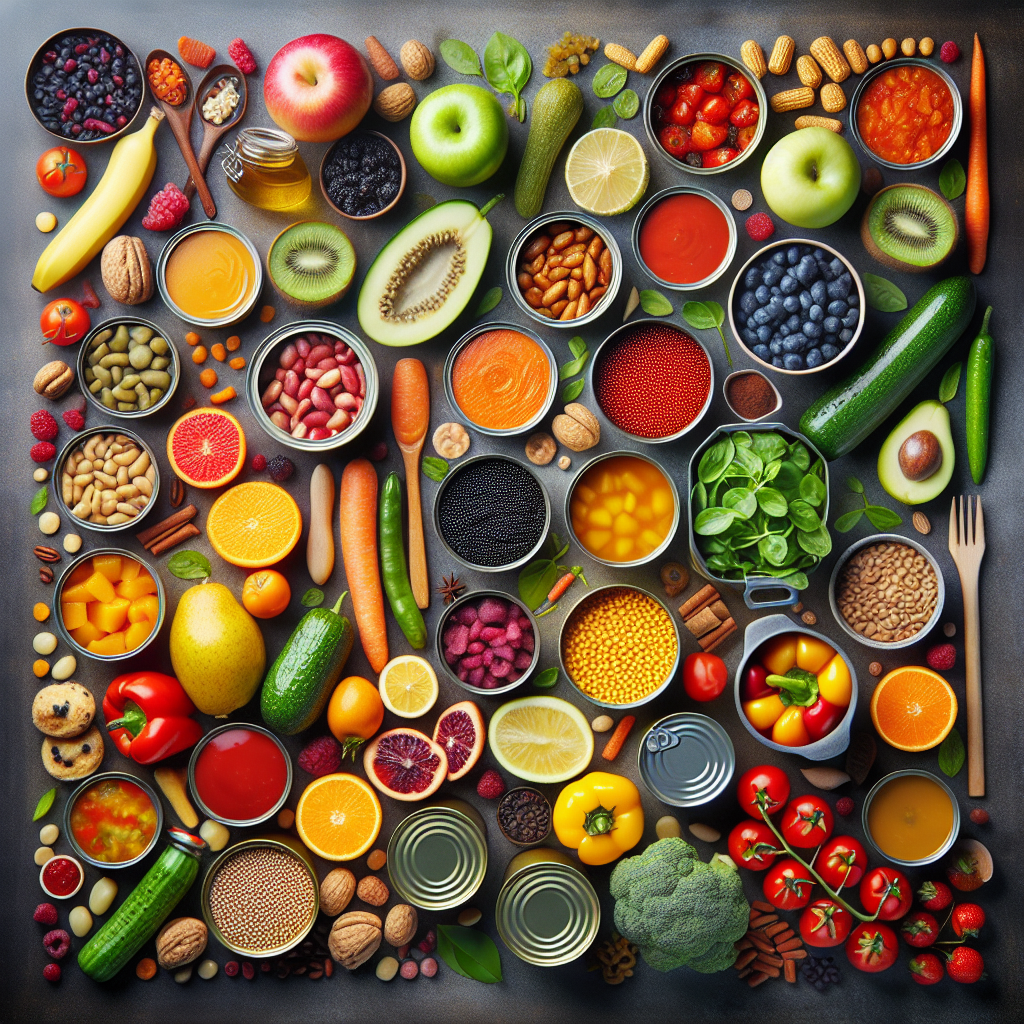Get ready to revolutionize your kitchen with the convenience and nutrition of canned foods! In today’s fast-paced world, finding time to prepare meals can be a challenge. However, with Tastepan’s collection of delicious recipes, you can whip up wholesome and satisfying dishes in no time. Don’t underestimate the power of canned foods – they offer a quick and easy solution for busy individuals who still want to prioritize their well-being. Whether you’re a seasoned chef or a beginner in the kitchen, our expert advice and dietary tips will guide you towards creating healthy meals that are bursting with flavor. Get ready to explore the world of cooking with canned foods, where convenience and nutrition come together seamlessly.

Benefits of Cooking with Canned Foods
Long Shelf Life
One of the major benefits of cooking with canned foods is their long shelf life. Unlike fresh ingredients that can spoil quickly, canned foods have an extended shelf life, allowing you to keep them stocked in your pantry for months or even years. This is especially useful for busy individuals or those living in remote areas where access to fresh ingredients may be limited.
Convenience
Cooking with canned foods offers unparalleled convenience. With canned ingredients, you can easily whip up a delicious meal in no time. They are pre-cooked and ready to use, saving you precious time in the kitchen. Whether you need a quick and easy dinner option or a snack on the go, canned foods provide a hassle-free solution.
Affordability
Another advantage of cooking with canned foods is their affordability. Canned ingredients are often more budget-friendly than their fresh counterparts, making them a great option for individuals on a tight budget. Additionally, buying canned foods in bulk can further reduce costs and provide even more savings in the long run.
Nutritional Value
Contrary to popular belief, canned foods can be just as nutritious as fresh ingredients. Many fruits and vegetables are canned at their peak ripeness, locking in essential vitamins and minerals. Canned foods are also an excellent source of fiber and can contribute to a well-balanced diet. Incorporating canned foods into your meals can help you meet your daily nutritional needs.
Tips for Choosing Canned Foods
Read the Labels
When shopping for canned foods, it is essential to carefully read the labels. Look for ingredients that are familiar and avoid products with artificial additives or high sugar content. Opt for labels that clearly state the nutritional information and the country of origin of the ingredients.
Look for Low Sodium
Sodium is often added to canned foods as a preservative. However, excessive sodium intake can be harmful to your health. Look for low-sodium or no-salt-added options when choosing canned foods. By doing so, you can reduce your sodium intake without compromising on taste.
Buy BPA-Free Cans
Bisphenol A (BPA) is a chemical compound commonly found in the lining of canned foods. Some studies suggest that BPA may have adverse effects on human health. To minimize exposure to BPA, opt for canned foods that are labeled as BPA-free. These cans use alternative linings that are considered safer for consumption.
Choose Organic Options
If you prefer to consume organic products, look for canned foods that are labeled as organic. Organic canned foods are made from ingredients that are grown without the use of synthetic pesticides, fertilizers, or genetically modified organisms (GMOs). Choosing organic options ensures that you are minimizing your exposure to potentially harmful chemicals.

Essential Canned Ingredients for Every Kitchen
Canned Tomatoes
Canned tomatoes are a versatile ingredient that can be used in a wide range of dishes. They form the base for many sauces, soups, and stews. Whether you’re making a classic marinara sauce or a hearty chili, having canned tomatoes in your pantry is a must for any home cook.
Canned Beans
Canned beans are a pantry staple that can add protein, fiber, and texture to your meals. They are convenient to use and can be added to salads, soups, or even mashed to create delicious bean spreads. From kidney beans to chickpeas, the variety of canned beans available allows you to explore different flavors and cuisines.
Canned Fish
Canned fish, such as tuna or salmon, provides a quick and easy way to incorporate seafood into your diet. It can be used in sandwiches, salads, or pasta dishes. Canned fish is a great source of omega-3 fatty acids, which are beneficial for heart health and brain function.
Canned Vegetables
Having a variety of canned vegetables in your pantry ensures that you always have a nutritious side dish or ingredient for your recipes. From corn and green beans to peas and carrots, canned vegetables are a convenient way to add vitamins and minerals to your meals.
Healthy Recipes Using Canned Foods
Canned Tomato Soup
Warm up on a cold day with a comforting bowl of canned tomato soup. Simply blend canned tomatoes with some vegetable broth, onion, garlic, and your favorite herbs and spices. Heat it on the stove until it simmers, and you’ll have a delicious homemade soup in no time.
Black Bean Salad
Create a refreshing and protein-packed salad using canned black beans. Combine the beans with diced bell peppers, corn kernels, red onion, and a simple dressing made with olive oil, lime juice, and cumin. This colorful salad is a perfect addition to any summer meal.
Tuna Casserole
Whip up a classic tuna casserole using canned tuna, cooked pasta, and a creamy sauce made from canned soup and cheese. Top it off with breadcrumbs and bake it in the oven until golden and bubbly. This hearty and satisfying dish is perfect for a quick weeknight dinner.
Vegetable Stir-Fry
Make a quick and nutritious vegetable stir-fry using a medley of canned vegetables. Heat some oil in a pan, add your favorite canned vegetables, and stir-fry with soy sauce, garlic, and ginger. Serve it over steamed rice or noodles for a complete meal.

Cooking Techniques for Canned Foods
Draining and Rinsing
When using canned foods, it is often recommended to drain and rinse them before incorporating them into your recipes. This helps remove excess sodium or syrup that may be present in the canning liquid. Draining and rinsing can also enhance the texture and flavor of canned ingredients.
Using the Liquid
In some recipes, the liquid from canned foods can be a valuable addition. For example, the liquid from canned beans, known as aquafaba, can be used as a vegan egg substitute in baking. Canned tomatoes can be used along with their juices to create a flavorful sauce or soup base. Experiment with using the liquid from canned foods to add depth of flavor to your dishes.
Blending and Pureeing
Canned foods can be easily blended or pureed to create smooth textures. For instance, canned tomatoes can be blended to make a smooth tomato sauce or pureed to make a creamy tomato soup. Canned beans can also be pureed to make dips or spreads. Blending and pureeing canned ingredients can help you achieve the desired consistency in your recipes.
Combining with Fresh Ingredients
Canned foods can be combined with fresh ingredients to create well-rounded and flavorful dishes. For example, you can add canned beans to a fresh salad or combine canned vegetables with freshly sautéed onions and garlic. By combining canned and fresh ingredients, you can enjoy the convenience of canned foods while still incorporating the freshness of produce.
Improving Flavors of Canned Foods
Using Herbs and Spices
Enhance the flavors of canned foods by adding herbs and spices. Whether it’s adding Italian herbs to canned tomatoes or sprinkling cumin and chili powder on canned beans, herbs and spices can elevate the taste of your dishes. Experiment with different combinations to find your favorite flavor profiles.
Sautéing and Seasoning
Sautéing canned vegetables or beans with onions, garlic, and your favorite seasonings can add depth and complexity to their flavors. The process of sautéing helps develop the natural sugars and caramelizes the ingredients, resulting in a richer taste. Seasoning canned foods with salt, pepper, or other spices can also help enhance their flavors.
Creating Homemade Sauces
Canned ingredients can be used as a base to create homemade sauces. For example, canned tomatoes can be simmered with herbs, garlic, and olive oil to make a flavorful pasta sauce. Canned beans can be combined with spices and blended to create a creamy sauce for enchiladas or tacos. Creating your own sauces allows you to control the flavors and customize them to your liking.
Adding Texture with Nuts and Seeds
To add a crunchy element to your dishes, consider incorporating nuts and seeds into your canned food recipes. Sprinkle toasted almonds or sunflower seeds over a canned vegetable salad for added texture. You can also blend canned ingredients with nuts or seeds to create spreads or dips with a satisfying crunch.
Canned Foods for Quick and Easy Desserts
Pineapple Upside-Down Cake
Create a timeless and delicious dessert using canned pineapple rings. Place the rings on the bottom of a cake pan, top it with a simple batter, and bake it until golden brown. When you flip the cake over, you’ll have a beautiful and sweet pineapple upside-down cake.
Three-Ingredient Chocolate Mousse
Indulge in a creamy and decadent dessert with just three ingredients. Whip together canned coconut cream, cocoa powder, and a sweetener of your choice to create a rich and silky chocolate mousse. Chill it in the refrigerator, and you’ll have a delightful treat in no time.
Fruit Cobbler
Make a warm and comforting fruit cobbler using canned fruits such as peaches or cherries. Mix the canned fruit with some sugar, spices, and a simple crumb topping made from flour, butter, and oats. Bake it in the oven until golden and bubbly, and serve it with a scoop of vanilla ice cream for a truly satisfying dessert.
Banana Bread
Use overripe bananas from your pantry to make a delicious banana bread. Simply mash the bananas, mix them with flour, sugar, and other ingredients, and bake until golden and fragrant. Canned bananas can be just as flavorful as fresh ones, making them a great choice for baking.
Storing Leftovers from Canned Food Meals
Refrigerating Properly
To store leftovers from meals made with canned foods, it is important to refrigerate them properly. Transfer the leftover food to an airtight container and place it in the refrigerator within two hours of cooking. Proper refrigeration helps prevent the growth of bacteria and ensures the safety of your leftover dishes.
Freezing for Extended Shelf Life
If you have a surplus of canned food leftovers, consider freezing them for extended shelf life. Transfer the leftovers to freezer-safe containers or bags, making sure to remove any excess air. Label the containers with the contents and date before placing them in the freezer. Properly frozen leftovers can be enjoyed for several months.
Safe Food Handling Practices
When handling canned food leftovers, it is important to follow safe food handling practices. Wash your hands before and after handling the food, and use clean utensils and containers. Avoid cross-contamination by storing different types of canned food leftovers separately. These practices help prevent foodborne illnesses and ensure the safety of your meals.
Labeling and Date-Marking
To keep track of your canned food leftovers, it is helpful to label and date-mark the containers. This allows you to easily identify the contents and the date they were stored. By following a first-in, first-out approach, you can ensure that you use the oldest leftovers first, minimizing food waste.
Common Misconceptions about Canned Foods
Lack of Nutritional Value
One common misconception about canned foods is that they lack nutritional value. While it is true that some nutrients may be lost during the canning process, canned foods can still be a valuable source of vitamins, minerals, and fiber. Many canned fruits and vegetables are picked and preserved at their peak ripeness, ensuring that they retain their nutritional benefits.
Added Preservatives
Another misconception is that canned foods are loaded with added preservatives. While some canned foods may contain preservatives, many manufacturers now offer options with minimal or no added preservatives. Reading the labels and choosing brands that prioritize natural preservation methods can help you avoid excessive preservatives in canned foods.
Lower Quality than Fresh Foods
Some may believe that canned foods are of lower quality compared to fresh foods. However, canned foods are often harvested and processed at their prime, ensuring that they maintain their texture and flavor. They undergo a rigorous canning process that seals in the natural goodness of the ingredients, making them a reliable and consistent option.
Environmental Concerns
There are concerns about the environmental impact of canned foods, particularly regarding packaging waste. While cans are not as environmentally friendly as fresh produce, they are highly recyclable. Additionally, the long shelf life of canned foods reduces food waste, which can be a significant contributor to environmental problems. Choosing cans made from recycled materials and responsibly disposing of them can help mitigate the environmental impact.
Conclusion
Cooking with canned foods offers numerous benefits, including long shelf life, convenience, affordability, and nutritional value. By following the tips for choosing canned foods and incorporating essential canned ingredients into your kitchen, you can create delicious and healthy meals. Explore different cooking techniques and flavor-enhancing methods to make the most of your canned ingredients. Don’t forget to store leftovers properly and be mindful of common misconceptions about canned foods. Enjoy the convenience and versatility that canned foods bring to your kitchen while nourishing your body with wholesome and flavorful meals.

